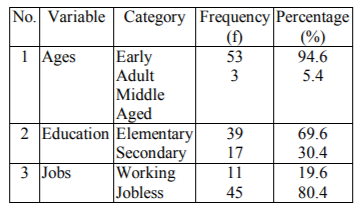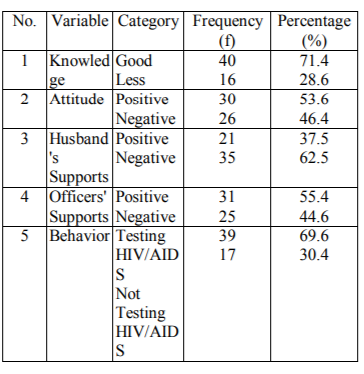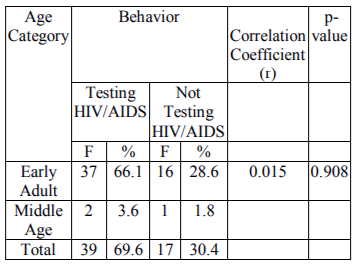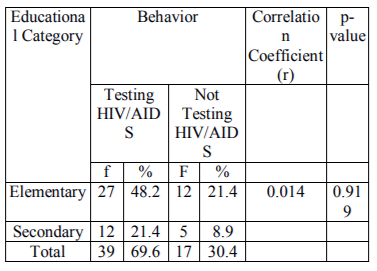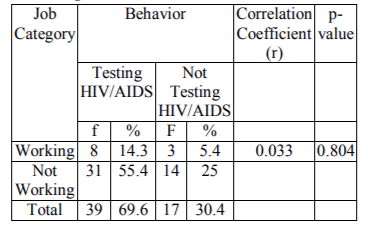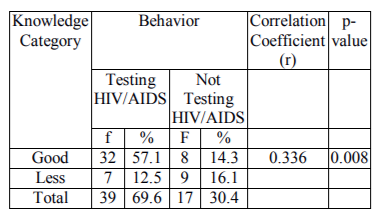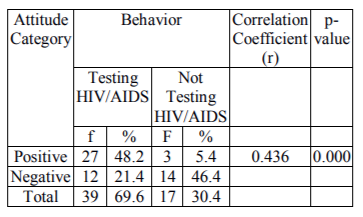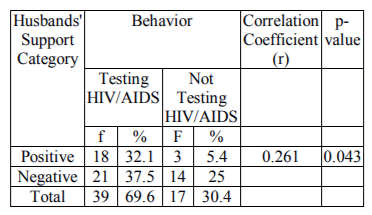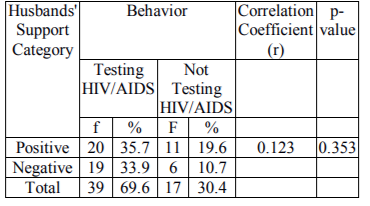Information
Journal Policies
HIV-AIDS Mitigating Case Paradox in Indonesia Small Town; Reluctance of Pregnant Women Undergoing the Screening
Suparmi1,Sri Widatiningsih2,Masini3
Copyright : © 2017 . This is an open access article distributed under the Creative Commons Attribution License, which permits unrestricted use, distribution, and reproduction in any medium, provided the original work is properly cited.
Introduction: In Banyumas District, Central Java, Indonesia the number of HIV / AIDS cases from 1993 to September 2015 was ranked 3rd in Central Java with 732 cases. At Health Community Center, there are 462 thousand pregnant women in 2016. From those figures, 247 people have undergone HIV / AIDS test while the rest of 215 pregnant women simply ignore the test.
The Objective: The purpose of this study to determine the determinants of pregnant women's behavior to test HIV / AIDS.
Method: The research was conducted at Health Community Center (in Indonesia is known Puskesmas) Baturaden I using cross-sectional approach. The study population is 56 pregnant women. The sampling technique uses total sampling, and the questionnaire is used to collect the data.
Result: The result of the study showed that there was a correlation between knowledge of the behavior of pregnant women on HIV test (p = 0.008). Also, there was a correlation between attitude and the behavior of pregnant women on HIV test (p = 0.000), and there was a relationship of husband support with the conduct of the pregnant women on HIV test = 0.043). There is no relationship between age, education, employment, and officer support with the behavior of pregnant women on HIV testing.
Conclusion: The results of the research can be used as an input material for the related officers to provide more information about HIV / AIDS to the wider community through health cadres, and for other researchers to extend the respondent characteristics.
HIV, Behavior, Women, Knowledge, Support,Public Health and Community Medicine
1. Introduction
Up to this point, more than 6.5 million women in Indonesia have become HIV / AIDS-prone populations as more than 30% of them deliver babies infected with HIV / AIDS.
Ministry of Health estimates that in Indonesia every year there are 9000 pregnant women with positive HIV / AIDS give birth to children, meaning that there will be about 3000 babies with HIV / AIDS every year. This condition will happen if there is no intervention. The risk of mother-to-child transmission of HIV / AIDS ranges from 25 to 45%. However, this risk can be reduced to about 1-2% with intervention measures for HIV / AIDS positive pregnant women, namely Prevention Program Mother to Child HIV Transmission (PMTCT) services, anti-retroviral drugs (ARV), caesarean sections and milk formulated for born babies (Hardon et. al, 2009)
In Central Java, the number of HIV / AIDS cases in 2013 was found 1045 cases HIV / AIDS and 993 AIDS cases whereas in 2014 in the third quarter was found 573 cases HIV / AIDS patients and 428 AIDS cases (Dinkes Provinsi Jateng, 2014).
In Banyumas district, the number of cases in 1993 to September 2015 was ranked 3rd in Central Java after 1091 cases in Semarang city, Surakarta Municipality with 738 cases and Banyumas District with 732 cases (Dinkes Banyumas, 2015).
According to Banyumas District Health Office, the discovery of HIV / AIDS case in Banyumas Regency from the report of VCT (Voluntary Counseling and Testing) Prof Dr. Margono Soekarjo Hospital and Banyumas Hospital in 2013 is as many as 215 cases. The occurrence increased in 2014 as many as 202 cases where the sufferers are mostly in productive ages who will have a risk of transmission against the partner.
HIV / AIDS testing during pregnancy is one of the efforts to prevent HIV / AIDS transmission from mother to child. The preliminary study conducted at Puskesmas I Baturaden Purwokerto in October 2016 revealed: Puskesmas I Baturaden already have VCT service since 2015 and every pregnant woman who perform pregnancy check must be tested HIV / AIDS. Based on data from Puskesmas I Baturaden the number of pregnant women in 2015 amounted to 495 people. Out of that number, those who had taken the test is a total of 170 mothers, and those did not perform the test was a total of 325 people. Furthermore, in 2016 the number of pregnant women are as many as 462 individuals who had tested HIV / AIDS, and 247 people have not done HIV / AIDS testing. Thus, pregnant women in the work area of Puskesmas I Baturaden not all test HIV / AIDS.
From the results of preliminary studies, the authors analyzed the various factors affect the behavior of pregnant women's reluctance to perform HIV / AIDS screening.
2. Materials And Methods
This research was carried out in the working area of Puskesmas I Baturaden of Banyumas Regency in January with Cross-Sectional approach.
The respondents used in this study were pregnant women who had not tested HIV / AIDS in Puskesmas I Baturaden area. 54 pregnant women taken with total sampling technique fulfilling inclusion criteria: pregnant women in the work area of Puskesmas Baturaden 1, pregnant women who have not done Test of HIV / AIDS, pregnant women willing to be respondents, mothers can read and write. The exclusion criteria include pregnant women who are not prepared to be respondents, pregnant women who have tested HIV / AIDS. All research subjects have approved and signed the informed consent.
The data collected came from primary data obtained directly from the respondents by filling out questionnaires containing the characteristics of age, education, occupation, knowledge, attitude, support of husband and health officer, and behavior of HIV / AIDS testing.
Data were analyzed with correlation coefficient test with the p- value < 0,05.
Table 1 indicates that the majority of pregnant women included in the early adult age category (94.6%) and most pregnant women possess primary education (69.6%), as well as most pregnant women, do not work (80.4%).
Table 2 shows that most respondents have sound knowledge (71.4%), most respondents have the right attitude (53.6%), most respondents have negative husband's support (62,5%), most respondents have officer support (55.4%), and most respondents have tested HIV / AIDS (69.6%).
Of the majority of respondents who tested HIV / AIDS were pregnant women in the early adult age category (66.1%), and similarly those who did not test HIV / AIDS most were expectant mothers with early adult age group (28.6%). The p- value = 0.908 > 0.05 indicates that the correlation between age and behavior testing HIV / AIDS was not statistically significant. A correlation value of 0.015 shows a positive correlation with a weak correlation strength.
The results of this study are not following Green, et.al (1991) where age including predisposing factors that can directly affect the occurrence of one's behavior. Based on the cross-tabulation analysis, the incidence of performing and not performing HIV / AIDS test behavior in the early adult age category is almost the same or relatively similar. This behavior is due to the same data, or the results of data collection on the respondents are not or less varied. This study supports research conducted by Legiati (2012) where there is no relationship between age and behavior of pregnant women for HIV testing. Of the majority of respondents who tested HIV / AIDS were pregnant women with primary education category (48.2%), and so did those not to check the HIV / AIDS most were expectant mothers with basic education group (21.4%). The p-value = 0.919 > 0.05 indicates that the correlation between education and behavior testing of HIV / AIDS was not statistically significant. A correlation value of 0.014 shows a positive correlation with a frail relationship strength.
Of the majority of respondents who tested HIV / AIDS were pregnant women with primary education category (48.2%), and so did those not to check the HIV / AIDS most were expectant mothers with basic education group (21.4%). The p-value = 0.919 > 0.05 indicates that the correlation between education and behavior testing of HIV / AIDS was not statistically significant. A correlation value of 0.014 shows a positive correlation with a frail relationship strength.
This study is not under Green, et.al (1991) where education includes predisposing factors that can directly affect the occurrence of a person's behavior. Pregnant women in the work area of Puskesmas Baturaden I majority have necessary education background which they feel by taking elementary school until high school is enough as a capital for the woman to take care of the household and educate the child. Also, most respondents have an essential educational background who chose not to test HIV / AIDS. It is possible they are less aware of HIV / AIDS so that in seeing and hearing things that are new there is a sense of doubt, and it takes a lot of time to consider an extreme behavior concerning the health and the baby in the birth. There is also a sense of worry or fear when positive HIV / AIDS test results confirmed, and respondents are not ready to accept the possibility of things that are scary making they choose not to test HIV / AIDS.
Of the majority of respondents who tested HIV / AIDS were pregnant women with unemployed category (55.4%), and those who did not test HIV / AIDS most were expectant mothers with non-working class (25%). The p-value = 0.804 > 0.05 indicates that the correlation between the work and the behavior of pregnant women on HIV / AIDS test was not statistically significant. A correlation value of 0.033 shows a positive correlation with a weak correlation strength.
The results of cross-tabulation analysis of the incidence of performing and not performing the HIV / AIDS test behavior in the most categories are almost the same or relatively similar due to homogenous respondents' job data or the results of data collection on the respondents are not or less varied. Besides, respondents who do not work have a tendency not to test HIV / AIDS because they have various reasons even though the examination is free of charge. Respondents are deciding a first health behavior for themselves in this case performing HIV / AIDS tests also think long if the examination results are positive. In the condition of husbands working to support the needs of families when the wife caught ill, they are increasingly afraid of getting stigma from the community, so they decided not to test HIV / AIDS. This study is similar to Rochyati (2006) who said that work has nothing to do with pregnant women who visit the Prevention Program clinic of the Mother to Child HIV Transmission (PMTCT).
Of the majority of respondents who tested HIV / AIDS were pregnant women with real knowledge category (57.1%), and those who did not test HIV / AIDS most were expectant mothers with less knowledge category (16.1%). The p-value = 0.008 < 0.05 indicates that the correlation between knowledge and behavior tested HIV / AIDS was statistically significant. But the correlation value of 0.336 shows a positive correlation with the weak correlation strength still.
Utomo & Ali (2014) also stated that HIV / AIDS is the knowledge and understanding of a person that influences the perception of the severity of illness and vulnerability. This way, the person will consider taking a precautionary measure against the disease which includes the mode of transmission, symptoms, and impacts as well as the benefits or obstacles in carrying out prevention.
In the case of HIV / AIDS and prevention behavior, a person's knowledge of the mode of transmission will affect the perception of susceptibility to infection. Likewise, the understanding of the symptoms and effects of HIV / AIDS will affect the perception of the severity of the disease. Both of these will encourage someone to think of a preventive behavior against HIV / AIDS. A good level of knowledge will affect a person's behavior in life. Good understanding about HIV / AIDS affects the prevention behavior. Thus, the results of research that has been done are following the existing theories.
Most of the respondents who tested HIV / AIDS were pregnant women with positive attitude category (48.2%), and those who did not test HIV / AIDS most were pregnant women with negative outlook category (46,4%). The p - value = 0.000 < 0.05 indicates that the correlation between attitudes and behaviors of HIV / AIDS testing was statistically significant. A correlation value of 0.436 indicates a positive correlation and a moderate correlation strength.
In this study, knowledge has a relationship with the behavior of testing HIV / AIDS is following the theory Notoatmodjo (2010). This is because most of the respondents are in early adulthood. Although most are of the little education graduates from only a primary education, respondents get knowledge about HIV / AIDS from social media information such as newspapers, television, radio, and also from health workers, so they have the motivation to do the HIV / AIDS test during the pregnancy. Also, they also get support from husbands and health workers where the respondents do the examination of gestation.
Most pregnant women who tested for HIV / AIDS were pregnant women with negative husband support categories (37.5%), and those who did not have the most HIV / AIDS test were pregnant women with negative man support classes (25%). The p-value = 0.043 < 0.05 indicates that the correlation between husband support and behavior testing HIV / AIDS was statistically significant. The correlation value of 0.261 shows a positive correlation with a weak correlation strength.
Support from a husband or family is one form of support that can improve maternal acceptance of HIV / AIDS testing during pregnancy. Support of a kind by a spouse or family is expected to reduce discrimination and stigma against people with HIV / AIDS, from their husbands or families in line with global goals in the prevention of HIV / AIDS worldwide, which is getting to zero (UNAIDS, 2011). Deaths due to HIV / AIDS can be lowered because sufferers get good support from their immediate environment such as husbands. Good support from neighboring people as well as medication can reduce transmission from patient to other people including mother-to-child transmission of HIV / AIDS. One of the activities to reduce HIV / AIDS infection from mother to child is by doing HIV / AIDS examination in the pregnant woman (Kemenkes RI, 2012).
Most of the respondents who tested HIV / AIDS were pregnant women with positive health care support category (35.5%), and those who did not test HIV / AIDS were pregnant women with active health officer support (19.6%). The p-value = 0.353> 0.05 indicates that the correlation between personnel support and HIV / AIDS testing behavior was not statistically significant. The correlation value of 0.123 shows a positive correlation with feeble relationship strength.
The results of this study are not in line with research conducted by Legiati (2012) stating that most of the pregnant women have done HIV / AIDS testing and the role of health workers as informants has a relationship in conducting the HIV / AIDS test. This discrepancy is probably due to the homogeneity of the answers to the questionnaires that have effects on the results of this study.
3. Conclusions
There is a relationship between knowledge, attitude, support of the husband with the behavior of pregnant women to perform HIV / AIDS testing. However, there is no connection between age, education, occupation, support of health workers with the behavior of pregnant women to perform HIV / AIDS testing.
References
- Dinas Kesehatan Provinsi Jawa Tengah. 2014. Profil Kesehatan Provinsi Jawa Tengah. Pemerintah Provinsi Jawa Tengah.
- Dinas Kesehatan Kabupaten Banyumas. 2015. Profil Kesehatan Dinas Kesehatan Banyumas.
- Hardon, A. P., Oosterhoff, P., Imelda, J. D., Anh, N. T., & Hidayana, I. (2009). Preventing mother-to-child transmission of HIV in Vietnam and Indonesia: diverging care dynamics. Social Science & Medicine, 69(6), 838-845.
- Green, B. L., Korol, M., Grace, M. C., Vary, M. G., Leonard, A. C., Gleser, G. C., & Smitson-Cohen, S. (1991). Children and disaster: Age, gender, and parental effects on PTSD symptoms. Journal of the American Academy of Child & Adolescent Psychiatry, 30(6), 945-951.
- Kemenkes RI, 2012. Pedoman Nasional Pencegahan Penularan HIV dari ibu ke Anak (PPIA) Tahun 2012. Jakarta.
- Legiati T, Shaluhiyah Z, Suryoputro A. Perilaku ibu hamil untuk tes HIV di kelurahan Bandarharjo dan Tanjung Mas kota Semarang. Jurnal Promosi Kesehatan Indonesia [internet]. 2012. Hal. 153-64. Available from: Journal Promosi Kesehatan Indonesia.
- Notoatmodjo, S. 2010. Ilmu Perilaku Kesehatan. Jakarta: Rineka Cipta
- Utomo, H. H., & Alie, Y. (2014). HUBUNGAN TINGKAT PENGETAHUAN TENTANG PENYAKIT TB PARU DENGAN MOTIVASI MELAKUKAN PEMERIKSAA NTB PARU DI WILAYAH KERJA PUSKE SMAS PLOSO KABUPATEN JOMBANG. Jurnal Metabolisme Vol. 3 No. 1 Januari 2014, 3(1).
- Rochyati, S. 2006. Gambaran pengetahuan dan sikap terhadap infeksi HIV pada Ibu Hamil yang Berkunjung ke Klinik PMTCT di Puskesmas Kecamatan Tebet Kotamadya Jakarta Selatan. Jakarta: Skripsi, Universitas Indonesia.





